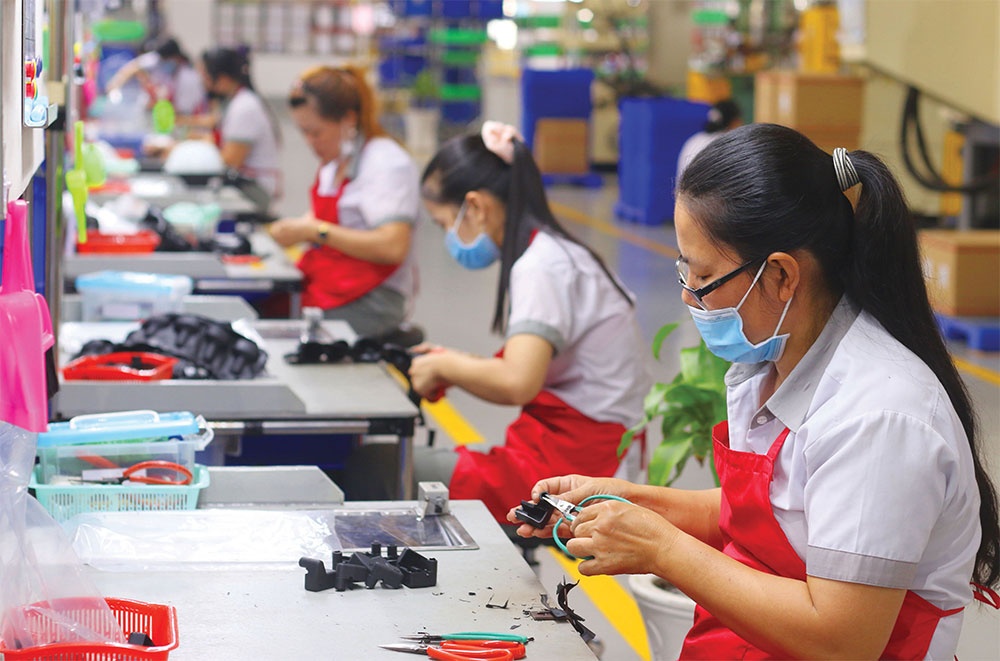Drastic moves vital for labour capacity
 |
| Official labour productivity figures are lower than those of 2016-2020, photo Le Toan |
The government reported to the National Assembly (NA) that this year, Vietnam’s labour productivity (LP) is forecast to increase 3.77-4.76 per cent, far lower than the NA’s goal of 5-6 per cent.
“This will be the third year in a row that we fail to reach the NA’s LP growth target. What is concerning is that the average LP increase is slowing,” said NA deputy Pham Trong Nghia, representing the northern province of Lang Son.
The rate is estimated to be about 4.5 per cent, far lower than the average of over 6 per cent for 2016-2020.
“It is strongly recommended that the government report the main causes behind such low LP growth and take drastic solutions to increasing LP,” Nghia said. “At the previous sessions, many NA deputies also raised their concern over the situation, with proposal that the government must have proper solutions to raise LP and take advantage of the country’s existing golden population.”
According to the International Labour Organization (ILO), productivity growth is important because it is the main source, and in the long run the only sustainable source of increasing the material standard of living of the population. It is not only a crucial dimension of overall productivity growth, but it also forms a direct link with income growth from employment. Furthermore, labour productivity depends on two key policy areas: human resources development through education and skills training and efficient labour market institutions and active labour market policies to enable and ensure a productive workforce.
The government reported that over the past few years, the economy’s human resources quality remains limited without clear changes, and has failed to become a breakthrough for national socioeconomic development.
Trained professions and careers have failed to stay in lockstep with the domestic labour market’s demand, especially those working in new economic sectors. Moreover, Vietnam also lacks high-skilled labourers in the key economic sectors and sectors in service of the digital economy.
Several organisations have pointed out Vietnam’s issue with poor quality labour. NA deputy Tran Van Khai, representing the northern province of Ha Nam, cited an assessment of the ILO that by last year, Vietnam’s LP was equal to 12.2 per cent of Singapore, 24.4 per cent of South Korea, and 58.9 per cent of China.
Meanwhile, the Asia Productivity Organization has also assessed that Vietnam’s LP is about 60 years behind that of Japan, 40 years of Malaysia, and 10 years of Thailand.
“When high-quality human resources are considered the key to socioeconomic development, economic restructuring, and growth model change, what have we done?,” Khai questioned. “According to the latest report from the Ministry of Planning and Investment, our country will need about 50,000-100,000 high-skilled workers for the semiconductor sector for 2025-2030. These figures show how Vietnam is thirsty for high-quality human resources. What will we do to develop such resources and increase the LP right in the national socioeconomic development plan for the 2023-2025?” Khai said.
Investment capital for improving scientific and technological activities in the economy in Vietnam remains humble and is now on a downtrend both in relative and absolute values, according to the Ministry of Science and Technology,
In 2021, total development investment into these activities reached about $1.33 billion, responsible for only 1.85 per cent of the economy’s total development investment capital. The state budget for such activities and research and development also remained at a low level of 0.58 per cent in 2021 – lower than the rate in 2019 of Malaysia of 1.13 per cent, and Singapore of 2.2 per cent.
The United Nations Development Programme (UNDP) said Vietnam must better prepare for, and adapt to, the impact of Industry 4.0 on drivers of growth and job creation.
“Accelerating Industry 4.0 offers both opportunities and risks in terms of future employment creation, as Vietnam embarks on new growth pathways. It is anticipated that automation and AI will displace jobs in several sectors that have been driving Vietnam’s growth,” said a UNDP report on Industry 4.0 impacting Vietnam.
Meanwhile, in Vietnam, about 1.6 million of new people enter the labour market annually, which creates a big burden for the government to provide sufficient employment. This burden is expected to grow further when Industry 4.0 is rising, with robots and high technology expected to replace many labourers, especially manual ones. The need for Vietnam to increase its LP has become increasingly imperative.
The ILO has suggested that about 70 per cent of jobs in Vietnam are at risk of automation. Sectors with a very high proportion of jobs at risk of automation include agro-forestry-fisheries, manufacturing, food and beverages, garments and textiles, electronics; retail, and others.
In September, Vietnam and the US upgraded their diplomatic relations to a comprehensive strategic partnership, in which both nations have decided to promote bilateral cooperation in science, technology, and innovation in the digital field.
“The US has recognised Vietnam’s great potential to become a key country in the semiconductor industry. The US supports the rapid development of the semiconductor ecosystem in Vietnam and will actively coordinate to enhance Vietnam’s position in the global semiconductor supply chain,” said NA deputy Tran Chi Cuong from the central province of Danang.
“Therefore, going forward, the potential to develop the semiconductor industry in Vietnam is huge with many opportunities to draw in investment, and receive and transfer technology from international corporations from the US and other partners. I believe this is a clear opportunity for the Vietnamese economy, and it will need to be considered and properly exploited.”
| Huynh Thanh Phuong - National Assembly deputy Tay Ninh province
According to economic experts, Vietnam’s LP in 2020 reached $20,400, which was very low compared to many countries in the region and the wider world. Therefore, improving and promoting LP is a core issue of the Vietnamese economy, and is the shortest path to bring the economy to develop quickly and sustainably, and catch up with the advanced development levels of countries. The growth rate of LP is not only an important goal, it also reflects the quality of growth as well as the competitiveness of the economy. We recommend that the government comprehensively evaluate the situation and propose more specific and drastic solutions to improve LP, and enhance the country’s labour force and gradually narrow the gap with other nations in the region and the wider world. Tran Thi Hong Thanh - National Assembly deputy Ninh Binh province
Improving LP is the core issue of Vietnam’s economy today, an urgent task that cannot be delayed. If we do not create a breakthrough in LP in the next 3-5 years, Vietnam is at risk of difficulty overcoming the middle income trap, and the goal of achieving a high income before the population ages will be difficult to come true. I have analysed the situation, the urgency of improving the LP, and identified the reasons for low LP. On that basis, I have proposed four groups of solutions to improve LP for the government to research and consider. Given the importance and urgent need to improve LP, I strongly suggest that the government pay special attention to developing and urgently effectively implementing solutions to improve LP so that our country can achieve the goals of sustainable, prosperous, and inclusive development in the spirit of the Resolution of the 13th National Party Congress. Nguyen Thị Tuyet Nga - National Assembly deputy Quang Binh province
According to some studies, our country’s LP has a giant gap compared to some countries in the region and developed countries. Therefore, the government needs to focus on improving this important indicator, improving the efficiency and quality of human resources, and effectively implementing strategic breakthroughs on human resource training. Although the government has made many innovations in vocational education and higher education, the rate of trained workers with certificates and degrees is still very low. Of particular concern is the shortage of creative scientists and leading experts in all areas of socioeconomic life. The quality of training is still limited and does not meet the requirements of the labour market, especially human resources, to meet new job requirements arising from economic development and international integration. |
 | High-quality overseas labour keen on Vietnam shift Vietnam’s promising economic factors could lead to more foreign workers and overseas Vietnamese entering the country to live and work. |
 | Vietnam sends over 132,000 labourers abroad in 10 months Vietnam sent more than 132,000 labourers abroad in the first 10 months of 2023, according to the Department of Overseas Labour under the Ministry of Labour, Invalids and Social Affairs (MoLISA). |
 | Human resources and the ties to vocational education The quality of Vietnam’s labour has been gradually improved, which is reflected in improved educational levels as well as the technical expertise of workers. This partly meets the requirements of businesses and the labour market. |
What the stars mean:
★ Poor ★ ★ Promising ★★★ Good ★★★★ Very good ★★★★★ Exceptional
Related Contents
Latest News
More News
- Protect what’s next: towards a future free from meningococcal group B disease (December 05, 2025 | 18:00)
- New ILO report offers policy recommendations for disability inclusion (December 04, 2025 | 15:18)
- Maternal job loss may affect children’s mental health, research shows (December 03, 2025 | 19:11)
- Women lead Vietnam’s shift to climate-resilient agriculture (December 03, 2025 | 19:10)
- Experts highlight unpaid care work as key barrier to gender equality (December 03, 2025 | 15:15)
- Opportunities and inequalities for women workers in Vietnam's garment industry (December 03, 2025 | 09:00)
- Vietjet flights carry love to devastated central region (November 28, 2025 | 11:35)
- New initiative to boost the fight against domestic violence (November 26, 2025 | 10:00)
- South Korea funds IOM relief for Vietnam’s typhoon-affected communities (November 24, 2025 | 15:33)
- AI and human-centred values set to shape the future of HR in Vietnam (November 21, 2025 | 18:04)




 Tag:
Tag:





















 Mobile Version
Mobile Version